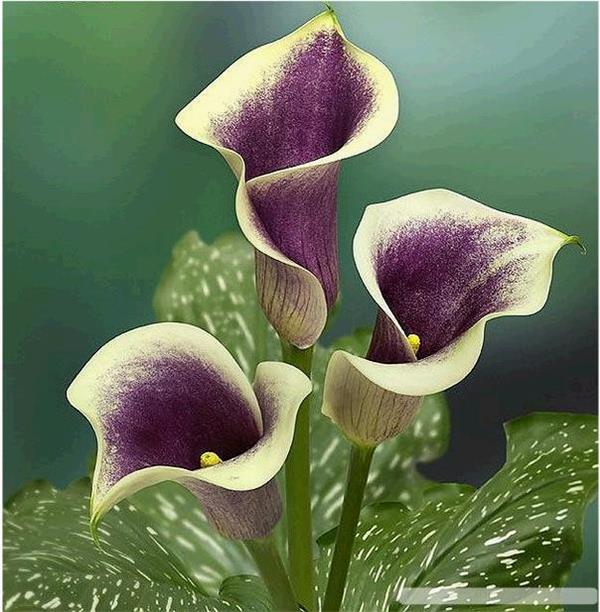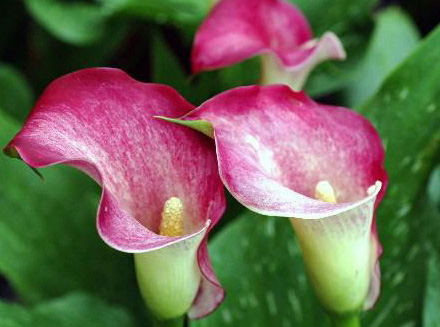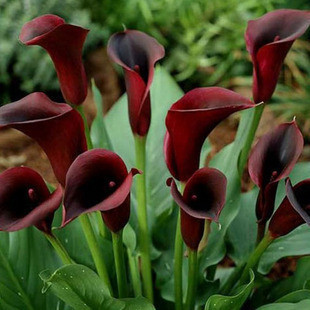Cultivation methods of colorful calla lilies
Colored calla lily colorful, elegant shape, whether leaves, or flowers, have a very high ornamental value. Colored calla lilies are native to Africa and like warm weather. They need plenty of light in winter and avoid direct sunlight in summer. The following is an introduction to the cultivation of colored calla lily.

The cultivation techniques of potted color calla lily are as follows:
Upper basin essentials
Pretreatment: After the seed ball arrives, gibberellin or bonin kinetin can be used to increase the number of flowers, gibberellin or bonin kinetin can be soaked in 50- 100ppm for 5-10 minutes, and then taken out and dried. The gibberellin treatment has little effect on the length of the flower stalk, but it will make the leaves become narrow and long, affecting the ornamental value. 500ppm chlorothalonil and 500ppm redotoxin can be soaked for 2 minutes, and then taken out and dried. This step is particularly important for the prevention and control of root rot and soft rot. When planting, the growth point is upward. Cover soil about 5 cm thick; After planting, rinse with clean water.
moisture management
Tubers need a lot of water. Water them regularly in the early stages of growth, but don't let the soil get too wet. When the leaves come out and enter the vigorous growth period, pay attention to seeing dry and wet. Watering is usually done in the morning, but in the afternoon if the weather is too hot.
Drip irrigation is a good way to retain moisture and is more suitable for use in windy weather. If spray irrigation is to be used, the distance between the nozzles should be accurate to ensure an even distribution of water. The sprinkler head must be 1 m higher than the plant and the sprinkler system must have sufficient pressure (at least 4 kg pressure). Disease resistance, especially soft rot resistance, decreases when plants are watered too much or too little.

fertilizer management
Colored calla lily belongs to flowers that need low fertilizer, and different types require different fertilizer levels. With balanced fertilizers with NPK ratios of 20-20-20 or 12:10:10, nitrogen concentrations of 100ppm are applied once a week or 200ppm are applied about twice a week.
dwarfing treatment
Potted color lotus varieties are usually 30-50 cm high, depending on the size of the pot and market demand to decide whether to dwarf treatment. Pyrimidyl alcohol and paclobutrazol were effective to color calla lily. Dwarfing treatment had obvious control on leaf length, but had little effect on flower stalk length.
pest control
A detailed application plan must be in place throughout the growing season, mainly with systemic insecticides. The main pests of calla lilies are thrips and aphids, and their control is particularly important because aphids can transmit viruses.
Spray should be started after budding, once every 7-10 days, and once every 3 weeks after flowering. The following drugs are more suitable for use on colored calla lilies: diazinon (diazinon), discide, maprolik (flucyanide), acephate and disithone granular drugs (systemic fungicides). These chemicals begin to work in moist conditions, are absorbed by the plant from the roots and conducted upward, and control aphids and thrips. These drugs are dangerous and should be used with special care. Mixed or rotated use of multiple pesticides can prevent pests from developing resistance. Note that the entire plant must be sprayed.

Seed ball disease control
Colored calla lilies are easily infected by pathogenic fungi and Rhizoctonia from the roots, and only after two weeks of infection, the aboveground parts will show yellow, wilting and curly leaves and other undesirable symptoms. Bacterial soft rot is easy to occur if it is wet. After planting, root irrigation with 0.5 g Rhizopus and 0.5 g Ryotoxymold in 1 liter of water is carried out every 2-4 weeks.
Pythium can be controlled with furazolam, but make sure it is harmless to the plant and do not spray pesticides for a week after spraying. Bacteria can be transmitted through irrigation and contaminated water on the ground. Strictly check the water source and take targeted treatment if there is pollution.
Flowering disease control
In humid or rainy seasons, it is common to have spots on the flower heads. Diseases susceptible to infection are gray mold and Alternaria wilt. Spray protective fungicides (such as chlorothalonil, captan, thiram, mancozeb, and tosulfamide) every 7-10 days to ensure that there are drug residues on the flowers.
When the disease is more serious, it is necessary to spray therapeutic fungicides in time (to withstand light rain and can be used at night when it is cold). The fungicides include rhizomicin, ipromicin and prochloraz. However, one kind should only be used 2-3 times per season, and sprayed in time 2-3 days before rain in wet season. Except during flowering, spraying cupromethide (copper hydroxide) once every 10 days can have a good protective effect (100 g/100 L).

Bacterial soft rot is a particularly serious problem on calla lilies. Good seed ball management will help control the occurrence of bacterial soft rot, especially during pilling and storage. When the soil temperature is higher than 23℃, the plant is susceptible to infection.
During the growth stage, when the resistance of plants weakened, they were susceptible to soft rot. A number of factors will result in reduced plant resistance, such as initial pathogen infestation, excessive humidity or dryness, phytotoxicity and fertilizer burning, excessive soil salinity, pre-emergence herbicide damage, excessive soil temperature, or unfavorable climatic conditions. Once infected with bacterial soft rot, bacteria will be difficult to eradicate, available protective "BTAPO" irrigation, and regular foliar spray can kill (copper hydroxide). The results showed that weak resistance and bacterial soft rot were the two main problems in the cultivation of calla. Bacterial soft rot is extremely prone to high humidity and high temperature conditions, and there are many practical experiences available to avoid these problems:
Use well-drained, oxygen-rich cultivation soils or substrates because bacterial soft rot is a facultative anaerobic bacterium;
Planting density should not be too sparse to use leaves as shade and reduce soil temperature;

To maintain a slightly acidic soil and high calcium concentration of tubers, the use of gypsum can increase calcium content, but does not increase the pH value, to avoid human and animal damage to the seed ball.
When the disease is more serious, it is necessary to spray therapeutic fungicides in time (to withstand light rain and can be used at night when it is cold). The fungicides include rhizomicin, ipromicin and prochloraz. However, one kind should only be used 2-3 times per season, and sprayed in time 2-3 days before rain in wet season. Except during flowering, spraying cupromethide (copper hydroxide) once every 10 days can have a good protective effect (100 g/100 L).
Bacterial soft rot is a particularly serious problem on calla lilies. Good seed ball management will help control the occurrence of bacterial soft rot, especially during pilling and storage. When the soil temperature is higher than 23℃, the plant is susceptible to infection.
During the growth stage, when the resistance of plants weakened, they were susceptible to soft rot. A number of factors will result in reduced plant resistance, such as initial pathogen infestation, excessive humidity or dryness, phytotoxicity and fertilizer burning, excessive soil salinity, pre-emergence herbicide damage, excessive soil temperature, or unfavourable climatic conditions. Once infected with bacterial soft rot, bacteria will be difficult to eradicate, available protective "BTAPO" irrigation, and regular foliar spray can kill (copper hydroxide). The results showed that weak resistance and bacterial soft rot were the two main problems in the cultivation of calla. Bacterial soft rot is extremely prone to high humidity and high temperature conditions, and there are many practical experiences available to avoid these problems:

Use well-drained, oxygen-rich cultivation soils or substrates because bacterial soft rot is a facultative anaerobic bacterium;
Planting density should not be too sparse to use leaves as shade and reduce soil temperature;
To maintain a slightly acidic soil and high calcium concentration of tubers, the use of gypsum can increase calcium content, but does not increase the pH value, to avoid human and animal damage to the seed ball.
When the disease is more serious, it is necessary to spray therapeutic fungicides in time (to withstand light rain and can be used at night when it is cold). The fungicides include rhizomicin, ipromicin and prochloraz. However, one kind should only be used 2-3 times per season, and sprayed in time 2-3 days before rain in wet season. Except during flowering, spraying cupromethide (copper hydroxide) once every 10 days can have a good protective effect (100 g/100 L).
Bacterial soft rot is a particularly serious problem on calla lilies. Good seed ball management will help control the occurrence of bacterial soft rot, especially during pilling and storage. When the soil temperature is higher than 23℃, the plant is susceptible to infection.
During the growth stage, when the resistance of plants weakened, they were susceptible to soft rot. A number of factors will result in reduced plant resistance, such as initial pathogen infestation, excessive humidity or dryness, phytotoxicity and fertilizer burning, excessive soil salinity, pre-emergence herbicide damage, excessive soil temperature, or unfavourable climatic conditions. Once infected with bacterial soft rot, bacteria will be difficult to eradicate, available protective "BTAPO" irrigation, and regular foliar spray can kill (copper hydroxide). The results showed that weak resistance and bacterial soft rot were the two main problems in the cultivation of calla. Bacterial soft rot is extremely prone to high humidity and high temperature conditions, and there are many practical experiences available to avoid these problems:
Use well-drained, oxygen-rich cultivation soils or substrates because bacterial soft rot is a facultative anaerobic bacterium;
Planting density should not be too sparse to use leaves as shade and reduce soil temperature;
To maintain a slightly acidic soil and high calcium concentration of tubers, the use of gypsum can increase calcium content, but does not increase the pH value, to avoid human and animal damage to the seed ball.
Bacterial soft rot is a particularly serious problem on calla lilies. Good seed ball management will help control the occurrence of bacterial soft rot, especially during pilling and storage. When the soil temperature is higher than 23℃, the plant is susceptible to infection.
During the growth stage, when the resistance of plants weakened, they were susceptible to soft rot. A number of factors will result in reduced plant resistance, such as initial pathogen infestation, excessive humidity or dryness, phytotoxicity and fertilizer burning, excessive soil salinity, pre-emergence herbicide damage, excessive soil temperature, or unfavourable climatic conditions. Once infected with bacterial soft rot, bacteria will be difficult to eradicate, available protective "BTAPO" irrigation, and regular foliar spray can kill (copper hydroxide). The results showed that weak resistance and bacterial soft rot were the two main problems in the cultivation of calla. Bacterial soft rot is extremely prone to high humidity and high temperature conditions, and there are many practical experiences available to avoid these problems:
Use well-drained, oxygen-rich cultivation soils or substrates because bacterial soft rot is a facultative anaerobic bacterium;
Planting density should not be too sparse to use leaves as shade and reduce soil temperature;

To maintain a slightly acidic soil and high calcium concentration of tubers, the use of gypsum can increase calcium content, but does not increase the pH value, to avoid human and animal damage to the seed ball.
When the disease is more serious, it is necessary to spray therapeutic fungicides in time (to withstand light rain and can be used at night when it is cold). The fungicides include rhizomicin, ipromicin and prochloraz. However, one kind should only be used 2-3 times per season, and sprayed in time 2-3 days before rain in wet season. Except during flowering, spraying cupromethide (copper hydroxide) once every 10 days can have a good protective effect (100 g/100 L).
Bacterial soft rot is a particularly serious problem on calla lilies. Good seed ball management will help control the occurrence of bacterial soft rot, especially during pilling and storage. When the soil temperature is higher than 23℃, the plant is susceptible to infection.
During the growth stage, when the resistance of plants weakened, they were susceptible to soft rot. A number of factors will result in reduced plant resistance, such as initial pathogen infestation, excessive humidity or dryness, phytotoxicity and fertilizer burning, excessive soil salinity, pre-emergence herbicide damage, excessive soil temperature, or unfavourable climatic conditions. Once infected with bacterial soft rot, bacteria will be difficult to eradicate, available protective "BTAPO" irrigation, and regular foliar spray can kill (copper hydroxide). The results showed that weak resistance and bacterial soft rot were the two main problems in the cultivation of calla. Bacterial soft rot is extremely prone to high humidity and high temperature conditions, and there are many practical experiences available to avoid these problems:

Use well-drained, oxygen-rich cultivation soils or substrates because bacterial soft rot is a facultative anaerobic bacterium;
Planting density should not be too sparse to use leaves as shade and reduce soil temperature;
To maintain a slightly acidic soil and high calcium concentration of tubers, the use of gypsum can increase calcium content, but does not increase the pH value, to avoid human and animal damage to the seed ball.
When the disease is more serious, it is necessary to spray therapeutic fungicides in time (to withstand light rain and can be used at night when it is cold). The fungicides include rhizomicin, ipromicin and prochloraz. However, one kind should only be used 2-3 times per season, and sprayed in time 2-3 days before rain in wet season. Except during flowering, spraying cupromethide (copper hydroxide) once every 10 days can have a good protective effect (100 g/100 L).
Bacterial soft rot is a particularly serious problem on calla lilies. Good seed ball management will help control the occurrence of bacterial soft rot, especially during pilling and storage. When the soil temperature is higher than 23℃, the plant is susceptible to infection.
During the growth stage, when the resistance of plants weakened, they were susceptible to soft rot. A number of factors will result in reduced plant resistance, such as initial pathogen infestation, excessive humidity or dryness, phytotoxicity and fertilizer burning, excessive soil salinity, pre-emergence herbicide damage, excessive soil temperature, or unfavourable climatic conditions. Once infected with bacterial soft rot, bacteria will be difficult to eradicate, available protective "BTAPO" irrigation, and regular foliar spray can kill (copper hydroxide). The results showed that weak resistance and bacterial soft rot were the two main problems in the cultivation of calla. Bacterial soft rot is extremely prone to high humidity and high temperature conditions, and there are many practical experiences available to avoid these problems:
Use well-drained, oxygen-rich cultivation soils or substrates because bacterial soft rot is a facultative anaerobic bacterium;
Planting density should not be too sparse to use leaves as shade and reduce soil temperature;
To maintain a slightly acidic soil and high calcium concentration of tubers, the use of gypsum can increase calcium content, but does not increase the pH value, to avoid human and animal damage to the seed ball.
Related
- Wuhan Hospital Iron Tree Blooming Result Was Instantly Frightened by the Gardener Master
- Which variety of camellia is the most fragrant and best? Which one do you like best?
- What is the small blue coat, the breeding methods and matters needing attention of the succulent plant
- Dormancy time and maintenance management of succulent plants during dormancy
- Minas succulent how to raise, Minas succulent plant pictures
- What are the varieties of winter succulent plants
- How to raise succulent plants in twelve rolls? let's take a look at some experience of breeding twelve rolls.
- Attention should be paid to water control for succulent plants during dormant period (winter and summer)
- Watering experience of twelve rolls of succulent plants
- Techniques for fertilizing succulent plants. An article will let you know how to fertilize succulent plants.



